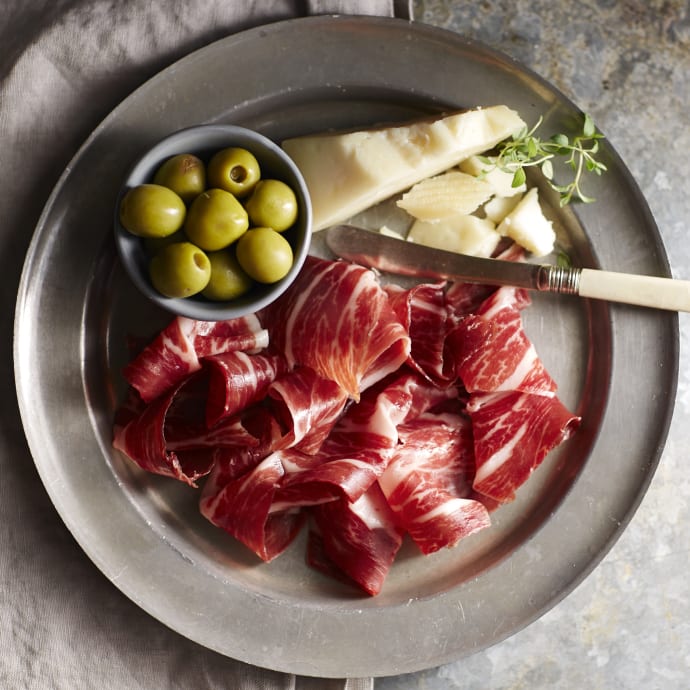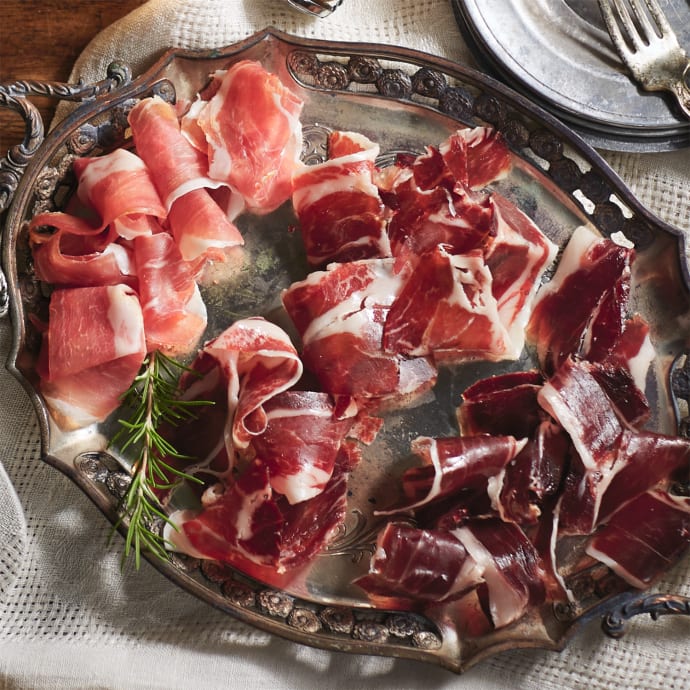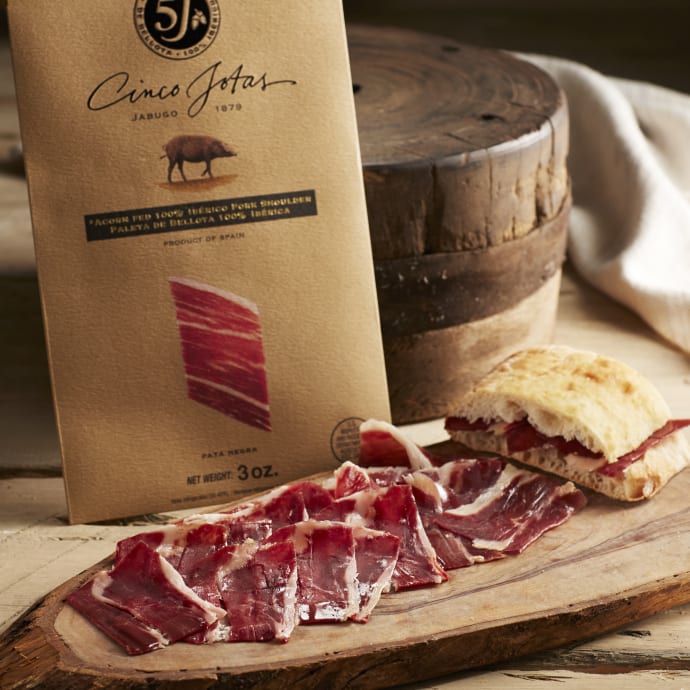
Virginia’s Ham
Virginia Law Weekly
-
March 18, 2011
Richard Massony
I’m standing over my largest cast-iron pot, using a wooden spoon to stir a murky, steaming broth, and wondering if something has gone terribly wrong. I have decided to spend my Sunday afternoon simmering a pot of New Orleans-style white beans with ham hocks, a comforting one-pot dish that will help me come down from the high of five days of Mardi Gras. However, there is something different about these beans: they are positively perfuming my apartment with an intense odor, a smell that is musky, sweet, and porky. Instead of using store-bought pork shanks, I am seasoning my beans with a single mammoth ham hock from one of Virginia’s oldest and finest ham producers, S. Wallace Edwards & Sons. The hock is almost the size of a cabbage, and its meat is darker and smokier than anything that might be called "ham" in a supermarket deli. It is a freak hock. And it is doing something to my beans.
The smell is not unfamiliar though. It is instantly recognizable to me as the smell of traditionally-cured Virginia ham, the same smell permeating Edwards’ curing and aging facility in Surry, Virginia, which I had the pleasure to tour in February with Edwards’ sales manager Keith Roberts.
I had contacted Roberts after tasting Edwards’ product at Charlottesville’s excellent specialty food store, Feast! While stopping in for lunch, I immediately gravitated toward their charcuterie bar to try some locally-produced salumi. After nibbling on excellent coppa and lomo from Richmond-based Olli Salumeria Americana, I sampled Edwards’ peanut-fed "Surryano" ham from the Surry Farms label. The wafer-thin slice, presented on a pad of wax paper, instantly glistened with natural oils when exposed to room temperature. The ham melted on my tongue like a fine Spanish jamón ibérico, releasing a sweet and salty richness. It certainly held its own against any expensive Italian prosciutto. This was unlike any Virginia ham I had tried before, and I wanted to learn more about it (and eat more of it).
That is what led me to drive two-and-a-half hours through a rainstorm on a chilly Friday morning to Surry, where Edwards’ maintains its modest 50,000 square-foot curing and aging facility. Roberts greeted me and then proceeded to guide me through the history of Virginia ham, the curing and aging process, and Edwards’ growing line of meat products.
Roberts explained that ham has been produced in this region since colonial times, when the dry salt-curing process allowed for the preservation of unused meat from slaughtered pigs that would otherwise spoil. Traditionally, hogs would be slaughtered in the winter, and their hindquarters (the hams) would be packed with salt and stored in a cool cellar. The salt leeched moisture from the meat, and thereby prevented spoilage. As the weather warmed during Spring, the hams would be taken from the salt and then hung to dry. During the Summer months, the hams would then be hickory smoked at low heat and left to hang for months. The resulting product was a salty, smoky meat with a more concentrated pork flavor.
While this process was used in a number of locales, Virginia’s terroir proved to be uniquely suited to curing hams. Furthermore, Virginia hogs were often allowed to graze in fields after the peanut harvest, so their diets were fortified with peanuts, giving the resulting hams a distinctive sweet flavor and oily richness. Thus, Virginia hams became known as a sought after product.
A third-generation family company, S. Wallace Edwards & Sons has been curing Virginia hams—using this traditional process—since the 1920’s. The Edwards family’s principal business was operating the Surry ferry on the James River, but in order to make some supplemental income they cured their own Virginia ham and sold it to ferry passengers in sandwiches. The ham was a sensation among tourists visiting nearby Williamsburg, and by 1926 Edwards had begun filling mail orders for whole hams. Ham production eventually became Edwards’ primary business.
Today, Edwards is one of the few remaining producers of real Virginia hams cured and aged using traditional methods. Roberts guided me on a tour of Edwards’ facilities, literally walking me through the process. The hams are salt-cured in refrigerated rooms replicating the effect of an un-insulated cellar during a Virginia winter. They are smoked with hickory wood and aged in warmer summer rooms for as long as eight months. "The process has not changed in any way, shape, or form," says Roberts. "We’ve just moved it indoors and cleaned it up a little bit."
In addition to the rigorous process, Roberts stressed Edwards’ attention to the raw product coming into the facility. Edwards will not accept any product that does not arrive within four days of the hogs being put down, and the meat must be kept within a very specific four-degree temperature range. Edwards prefers to source its hams from local sources. "We like to stay as close to home as possible," Roberts says. This is a practical consideration, as shipping costs and freshness are paramount. It does not make business sense to invest the time, labor, and curing room real estate to a ham if it is more likely to spoil. Finally, Roberts explained that they want the hogs to be as stress-free as possible when they are slaughtered, as high stress can actually damage the integrity of the animal’s tissue. It is for this reason that Edwards’ hogs are not put down in the hot summer months and that electrocution as a method of slaughter is frowned upon.
Edwards currently makes a number of varieties of ham, from the basic Edwards ham, which is aged 90 days, to the hoof-on Wigwam ham and the high-end Surryano hams, which are aged up to 18 months. The trademarked Surryano, which gets its name from a combination of Spanish Serrano ham and Edwards’ hometown of Surry, is their newest product. It is made exclusively from peanut-fed Berkshire hogs, certified humane, and aged for over 450 days. Like its European counterparts, it is shelf stable due to the long aging process. However, unlike prosciutto or Serrano, the Surryano is smoked and generally treated like a traditional Virginia ham. "We’re not trying to do the same thing as the European hams. This is a top-notch domestic country ham," Roberts explains.
Edwards also makes its own bacon as well as a distinctive Sage-flavored Surry Sausage, and there are other limited distribution items such as their ham hocks. Roberts said that they are experimenting with new products such as lardo and lomo. For now, Edwards’ products can be found in Charlottesville at Foods of All Nations, the Organic Butcher, and Feast!
Despite my fleeting concern about the smell emanating from my white beans, when I finally taste them they are rich and delicious. I have had this dish countless times before, but I feel like I am tasting this Creole staple for the first time. The ham flavor is no longer a bit player, it takes center stage. The hock is still intact, but gentle prying with a fork and knife loosens some of the soft flesh from the bone. The flavor, though rendered gentler in the stew, is deep and round, salty and sweet. This is Virginia ham.
I’m standing over my largest cast-iron pot, using a wooden spoon to stir a murky, steaming broth, and wondering if something has gone terribly wrong. I have decided to spend my Sunday afternoon simmering a pot of New Orleans-style white beans with ham hocks, a comforting one-pot dish that will help me come down from the high of five days of Mardi Gras. However, there is something different about these beans: they are positively perfuming my apartment with an intense odor, a smell that is musky, sweet, and porky. Instead of using store-bought pork shanks, I am seasoning my beans with a single mammoth ham hock from one of Virginia’s oldest and finest ham producers, S. Wallace Edwards & Sons. The hock is almost the size of a cabbage, and its meat is darker and smokier than anything that might be called "ham" in a supermarket deli. It is a freak hock. And it is doing something to my beans.
The smell is not unfamiliar though. It is instantly recognizable to me as the smell of traditionally-cured Virginia ham, the same smell permeating Edwards’ curing and aging facility in Surry, Virginia, which I had the pleasure to tour in February with Edwards’ sales manager Keith Roberts.
I had contacted Roberts after tasting Edwards’ product at Charlottesville’s excellent specialty food store, Feast! While stopping in for lunch, I immediately gravitated toward their charcuterie bar to try some locally-produced salumi. After nibbling on excellent coppa and lomo from Richmond-based Olli Salumeria Americana, I sampled Edwards’ peanut-fed "Surryano" ham from the Surry Farms label. The wafer-thin slice, presented on a pad of wax paper, instantly glistened with natural oils when exposed to room temperature. The ham melted on my tongue like a fine Spanish jamón ibérico, releasing a sweet and salty richness. It certainly held its own against any expensive Italian prosciutto. This was unlike any Virginia ham I had tried before, and I wanted to learn more about it (and eat more of it).
That is what led me to drive two-and-a-half hours through a rainstorm on a chilly Friday morning to Surry, where Edwards’ maintains its modest 50,000 square-foot curing and aging facility. Roberts greeted me and then proceeded to guide me through the history of Virginia ham, the curing and aging process, and Edwards’ growing line of meat products.
Roberts explained that ham has been produced in this region since colonial times, when the dry salt-curing process allowed for the preservation of unused meat from slaughtered pigs that would otherwise spoil. Traditionally, hogs would be slaughtered in the winter, and their hindquarters (the hams) would be packed with salt and stored in a cool cellar. The salt leeched moisture from the meat, and thereby prevented spoilage. As the weather warmed during Spring, the hams would be taken from the salt and then hung to dry. During the Summer months, the hams would then be hickory smoked at low heat and left to hang for months. The resulting product was a salty, smoky meat with a more concentrated pork flavor.
While this process was used in a number of locales, Virginia’s terroir proved to be uniquely suited to curing hams. Furthermore, Virginia hogs were often allowed to graze in fields after the peanut harvest, so their diets were fortified with peanuts, giving the resulting hams a distinctive sweet flavor and oily richness. Thus, Virginia hams became known as a sought after product.
A third-generation family company, S. Wallace Edwards & Sons has been curing Virginia hams—using this traditional process—since the 1920’s. The Edwards family’s principal business was operating the Surry ferry on the James River, but in order to make some supplemental income they cured their own Virginia ham and sold it to ferry passengers in sandwiches. The ham was a sensation among tourists visiting nearby Williamsburg, and by 1926 Edwards had begun filling mail orders for whole hams. Ham production eventually became Edwards’ primary business.
Today, Edwards is one of the few remaining producers of real Virginia hams cured and aged using traditional methods. Roberts guided me on a tour of Edwards’ facilities, literally walking me through the process. The hams are salt-cured in refrigerated rooms replicating the effect of an un-insulated cellar during a Virginia winter. They are smoked with hickory wood and aged in warmer summer rooms for as long as eight months. "The process has not changed in any way, shape, or form," says Roberts. "We’ve just moved it indoors and cleaned it up a little bit."
In addition to the rigorous process, Roberts stressed Edwards’ attention to the raw product coming into the facility. Edwards will not accept any product that does not arrive within four days of the hogs being put down, and the meat must be kept within a very specific four-degree temperature range. Edwards prefers to source its hams from local sources. "We like to stay as close to home as possible," Roberts says. This is a practical consideration, as shipping costs and freshness are paramount. It does not make business sense to invest the time, labor, and curing room real estate to a ham if it is more likely to spoil. Finally, Roberts explained that they want the hogs to be as stress-free as possible when they are slaughtered, as high stress can actually damage the integrity of the animal’s tissue. It is for this reason that Edwards’ hogs are not put down in the hot summer months and that electrocution as a method of slaughter is frowned upon.
Edwards currently makes a number of varieties of ham, from the basic Edwards ham, which is aged 90 days, to the hoof-on Wigwam ham and the high-end Surryano hams, which are aged up to 18 months. The trademarked Surryano, which gets its name from a combination of Spanish Serrano ham and Edwards’ hometown of Surry, is their newest product. It is made exclusively from peanut-fed Berkshire hogs, certified humane, and aged for over 450 days. Like its European counterparts, it is shelf stable due to the long aging process. However, unlike prosciutto or Serrano, the Surryano is smoked and generally treated like a traditional Virginia ham. "We’re not trying to do the same thing as the European hams. This is a top-notch domestic country ham," Roberts explains.
Edwards also makes its own bacon as well as a distinctive Sage-flavored Surry Sausage, and there are other limited distribution items such as their ham hocks. Roberts said that they are experimenting with new products such as lardo and lomo. For now, Edwards’ products can be found in Charlottesville at Foods of All Nations, the Organic Butcher, and Feast!
Despite my fleeting concern about the smell emanating from my white beans, when I finally taste them they are rich and delicious. I have had this dish countless times before, but I feel like I am tasting this Creole staple for the first time. The ham flavor is no longer a bit player, it takes center stage. The hock is still intact, but gentle prying with a fork and knife loosens some of the soft flesh from the bone. The flavor, though rendered gentler in the stew, is deep and round, salty and sweet. This is Virginia ham.
Other Press
A trio of savory snacks to enjoy this fall
Atlanta Journal-Counstitution
-
November 1, 2024
This Classic Garlic Keeper Is the One Thing I Made Sure I Brought Back from Spain
The Kitchn
-
July 10, 2024
That's How the Light Gets In
Defense Visual Information Distribution Service
-
April 20, 2024
See How Jamón Gets Made in the Heartland of Spanish Pork
Washington Post
-
April 16, 2024
Featured Products
 SHIPS FREE
SHIPS FREECinco Jotas Boneless 100% Ibérico de Bellota Jamón - FREE SHIPPING!
JM-107
$1,479.00$1,479.00
 SHIPS FREE
SHIPS FREECinco Jotas Bone-In 100% Ibérico de Bellota Jamón - FREE SHIPPING!
JM-106
$1,499.00$1,499.00

Sliced Ibérico Ham by Peregrino, Nitrate Free - 2 oz
JM-23
(33)
$23.00$23.00

Sliced Ibérico de Bellota Ham by Peregrino, Nitrate Free - 2 oz
JM-52
(44)
$39.00$39.00

Jamón Tasting Trio of Sliced Ham
JM-25
(29)
$79.00$79.00

Cured Meats of Spain Sampler
JM-45
(30)
$99.00$99.00

Cinco Jotas Sliced 100% Ibérico de Bellota Shoulder - 3 oz
JM-111
(17)
$49.00$49.00







